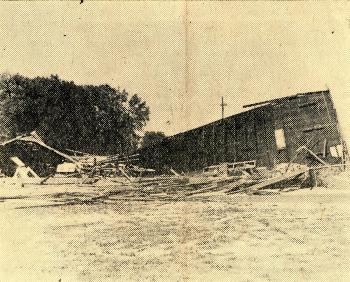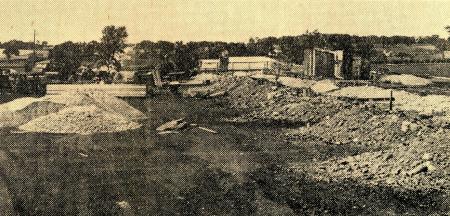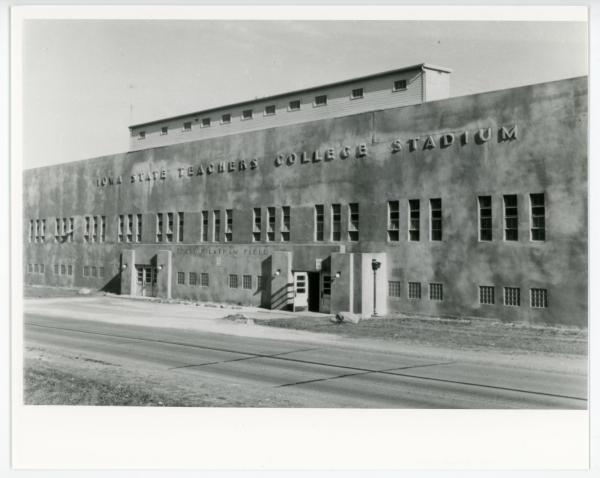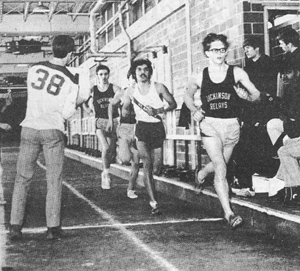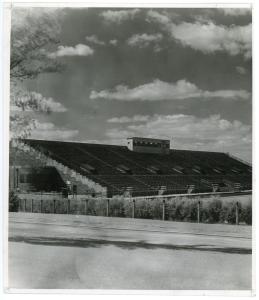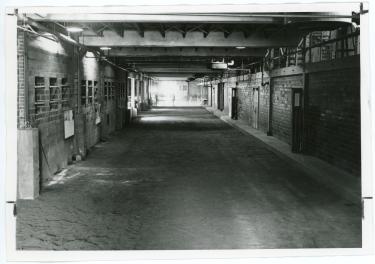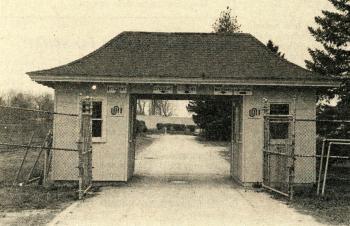Following the completion of the Men’s Gymnasium in 1925, the Iowa State Teachers College, now the University of Northern Iowa, prepared to move the football field out to that same general area of campus. For about thirty years, football had been played on a field located where the Rod Library now stands. But, over those years, academic and service building development had moved toward the field and had begun to crowd the athletics facilities. So, following the acquisition of the land needed to build the Men’s Gymnasium, it also became possible to develop a new football field farther west. Officials selected a site between the Men’s Gymnasium and Hudson Road. Grading the area and developing the turf took several years before the new football stadium could be dedicated on October 6, 1928. A quarter mile track encircled the field. Football fans could enjoy the games from new wooden grandstands.
In the following years, the Teachers College made significant improvements to the new stadium. A new press box that seated nineteen was added for the 1931 season. Additional bleachers doubled the stadium's seating capacity for the 1932 season. And, during the very dry summer of 1934, the college used a fire hose to keep the turf in good shape and also managed to complete painting projects around the facility.
But on July 22, 1936, a strong windstorm, possibly a tornado, moved across the Iowa State Teachers College campus and destroyed the wooden football field bleachers.
After the storm, the Board of Education made $10,000 available to the college to replace the bleachers. This was all the cash that the Board had on hand; it had no legal authority to borrow money or sell bonds for facilities other than dormitories. With that money, the college hoped to begin work on a new stadium very quickly. Officials hoped to be able to build the initial phase of the stadium in time for the home game against Grinnell on October 3, an incredibly fast construction schedule. Keffer and Jones of Des Moines were the architects for the project. Bids were opened on August 17, 1936. The N. H. Hansen Company of Waterloo received a $13,484 contract, and work got underway almost immediately.
The initial phase of construction would include a concrete and steel structure, eventually to be faced with brick, about 304 feet long, and seating two thousand people. As money became available for further construction, the seating capacity would be doubled, and a bandstand, press box, and restrooms would be added.
The construction company encountered difficulty in securing the steel that it needed for the project. Consequently, Boy Scout Day activities, which were to be associated with the October 3 game, were canceled and the game was played at West High School in Waterloo. A crowd of 3500 saw the Panthers defeat Grinnell, 24-0 The new stadium was sufficiently complete for the home game on October 17, 1936, against Coe.
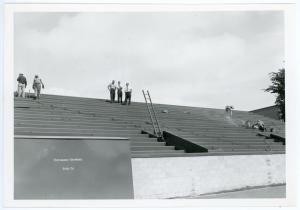 The Panthers won their first game in the new stadium, 21-0, but special Dad's Day activities were postponed until the October 31 game against the Haskell Indians, from Lawrence, Kansas, when facilities would be in better shape to entertain the visiting Dads. Six large felt pennants, in the colors of the North Central Conference teams, floated over the stadium.
The Panthers won their first game in the new stadium, 21-0, but special Dad's Day activities were postponed until the October 31 game against the Haskell Indians, from Lawrence, Kansas, when facilities would be in better shape to entertain the visiting Dads. Six large felt pennants, in the colors of the North Central Conference teams, floated over the stadium.
After completing the 1936 season in the hastily built and unfinished new facility, the college wanted to expand seating capacity and improve other football field facilities as well. Students were especially eager for a modern, electric scoreboard for the stadium. Since the Board of Education believed that it could not legally assist with funding, the college pursued federal funding.
When it became clear that federal money was unavailable for this purpose, ISTC President O. R. Latham, Physical Education Department Head L. L. Mendenhall, and Business Manager Benjamin Boardman proposed the organization of a private corporation to secure funding for the stadium. The organization would then build the stadium and rent it to the college. When rent paid by the college equaled the corporation's investment, plus interest, the facility would then be owned by the state. The Board of Education approved this arrangement. The 33,575 square foot stadium cost $110,000. Work got underway on June 1, 1939. Some members of the football team worked on the construction crew.
Although many interior features were still unfinished, the improved facility was sufficiently complete to allow a game to be played there on September 23, 1939, when the Panthers defeated Northeast Missouri Teachers College, 12-0.
The new facility included a football field, an outdoor track, and the stadium building. Crushed coal cinders from the campus power plant were utilized as a base for the outdoor track.
Within the stadium were locker rooms, equipment rooms, shower rooms, rest rooms, an indoor running track, and batting cages. On the exterior of the stadium there was a band shell, a press box, and a radio booth. The college also could offer about five hundred additional parking spaces after it purchased a four and one half acre parcel of land just west of the stadium in the summer of 1940.

Stadium seating included six thousand permanent seats along with another two thousand temporary seats on wooden bleachers on the east side of the field.
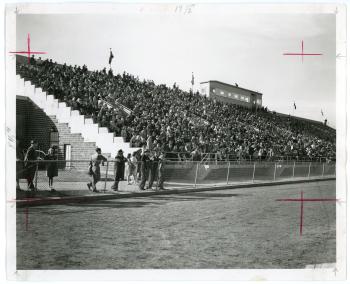 Writers in the College Eye asked several times for a formal dedication ceremony for the new stadium. However, with the lengthy funding and construction process stretching from 1936 through 1939, the time just never seemed to be appropriate. During those years the facility was known as the Iowa State Teachers College Stadium. But an unfortunate event brought about a formal dedication and name change. Homecoming, October 26, 1940, saw the dedication of the facility as the O. R. Latham Stadium in honor of the college's third president, Orval Ray Latham, who died unexpectedly July 9, 1940. President Latham was a strong believer in the value of intercollegiate athletics. He, as much as anyone else, was responsible for seeing that the stadium project was finally brought to a successful completion. Henry C. Shull, president of the Board of Education, spoke at the dedication.
Writers in the College Eye asked several times for a formal dedication ceremony for the new stadium. However, with the lengthy funding and construction process stretching from 1936 through 1939, the time just never seemed to be appropriate. During those years the facility was known as the Iowa State Teachers College Stadium. But an unfortunate event brought about a formal dedication and name change. Homecoming, October 26, 1940, saw the dedication of the facility as the O. R. Latham Stadium in honor of the college's third president, Orval Ray Latham, who died unexpectedly July 9, 1940. President Latham was a strong believer in the value of intercollegiate athletics. He, as much as anyone else, was responsible for seeing that the stadium project was finally brought to a successful completion. Henry C. Shull, president of the Board of Education, spoke at the dedication.
On July 4, 1944, the stadium was the site of a Navy Bond Show, with a band made up of US Navy personnel. Veterans who had returned from battle spoke to the crowd of five thousand. The show raised $10,000 in war bonds and stamps.
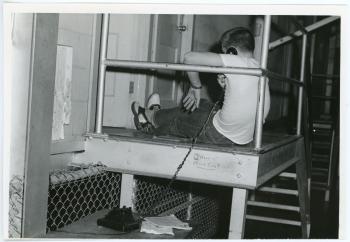
In October 1946, President Price announced that plans had been completed to convert the stadium mezzanine level into a dormitory to accommodate 160 men, part of the GI surge in enrollment following World War II. This area had been used during the war to house military personnel. Each of the twenty rooms, measuring 24 ft. x 12.5 ft., would contain four double-decked beds and would be heated by individual steam heating units. An additional four rooms of similar size would be used as study rooms. There would also be a recreation room and another large study hall at the north end of the stadium balcony. President Price stated that Stadium Hall, as it came to be known, was planned to be used as a dormitory for only ten years or so, until proper facilities could be built.

Typical of the post-war economy, steel and other supplies for the conversion were hard to find, and construction was delayed. Facilities were not complete until the fall term of 1947. When the facility opened, Lula Manson was house director during the week, with former Dean of Men Leslie I. Reed in charge on weekends. Eight upperclassmen served as hall counselors. Already by the summer of 1949 Dean of Men Paul Bender announced plans to remodel Stadium Hall. Dean Bender hoped that a more homey atmosphere would be conducive to study, and would help Stadium Hall residents improve their scholastic achievement levels. In the fall of 1950, a scholarship committee organized a program of films and speakers in hopes of helping residents understand the "importance of maintaining a favorable scholastic record while in school." Perhaps as a consequence, the number of "D" letters in Stadium Hall dropped by twenty per cent for the fall 1950 term.

In quarters obviously quite different from those of other campus dormitory dwellers, Stadium Hall men developed a spirit of their own. As reported in a February 1951 College Eye article: "We have our cold winter walks and winter drafts, but with the spirit and enthusiasm which prevails over here in Stadium Hall, we also feel that the active program provided is indicative of what we feel to be the best hall on the campus!" Outsiders, though, saw real problems with Stadium Hall: namely, crowded living conditions, noise, and water leaks. This give and take continued through the 1950s, with outsiders deploring, and residents generally defending the quality of life in Stadium Hall. But when plans were announced for a new men's residence hall in October 1959, later to be named Rider Hall, the days of Stadium Hall were numbered. The last residents of Stadium Hall moved out on November 28, 1961.
Lighting was added to the football field for the 1948 football season at a cost of about $13,000. The first night game was played October 2, 1948. The exterior of O. R. Latham Stadium received a face-lift in 1953. Construction began on East Stadium in 1963; this new structure, which cost $70,000, replaced the old wooden bleachers that had been installed nearly twenty-five years earlier. The East Stadium was completed in 1965 and contained restrooms and concessions stands. With the completion of the East Stadium, the older structure on the west side of the field, previously known simply as the Stadium, became known as the West Stadium. The capacity of the combined seating areas was approximately 7200.
Over the years, the stadium was the site of many functions such as Commencement, Fourth of July celebrations, and concerts, as well as athletics events.
 About the only significant improvement to the stadium during its last years was the installation in 1970 of new fiberglass seat covers, done in burnt gold, in the first ten rows of the West Stadium.
About the only significant improvement to the stadium during its last years was the installation in 1970 of new fiberglass seat covers, done in burnt gold, in the first ten rows of the West Stadium.
The last football game played in O. R. Latham Stadium was the infamous Mud Bowl play-off game against Western Kentucky University in 1975. UNI was defeated, 14-12. Years later Coach Stan Sheriff said, "We practiced in two foot snowdrifts all week . . . And then the day we played, first there was sunshine, then it began to rain, then the rain turned to sleet, and the sleet turned to snow . . . We sold eight thousand tickets to the game, but only five people showed up for it." Even if Coach Sheriff exaggerated just a bit about the attendance, it was a miserable game. Thereafter, home games were scheduled in the newly-built UNI-Dome.
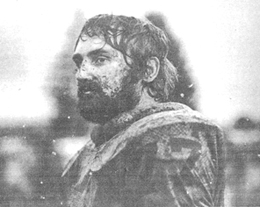
The West Stadium was demolished in the summer of 1976. The East Stadium continued to be used for recreation and intramural sports. Athletes used the 440 yard track and the Marching Band used the old football field as practice facilities. The rest of East Stadium was used to store university property. In the summer of 1987, East Stadium was demolished because it was not cost effective to repair the structure. The track and football field were also removed and the space once occupied by O. R. Latham Stadium was converted into the large parking lot, just west of the Schindler Education Center, at a cost of about $350,000.
If Latham Stadium were still in place today, vehicles would be driving on busy Hudson Road behind or west of the stadium. The UNI-Dome is standing today west of the Stadium in the field.
Compiled by Library Assistant Gail Briddle; edited by University Archivist Gerald L. Peterson, July 2001; substantially revised by Gerald L. Peterson, with research assistance by Student Assistant Anthony Boggs, October 2003; last updated, November 3, 2011 (GP); photos and citations updated by Graduate Assistant Eliza Mussmann February 1, 2023.

